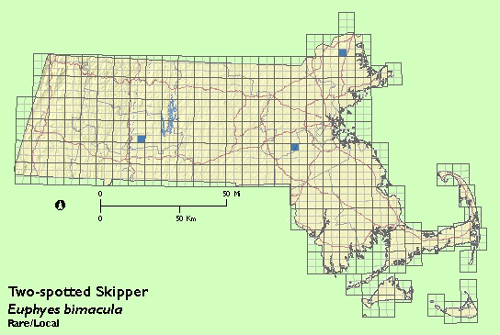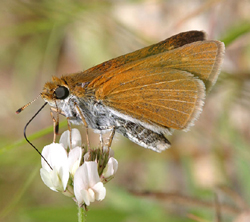Find a Butterfly
Two-spotted Skipper
Euphyes bimacula
Named
Grote and Robinson, 1867

Identification
Wingspan 1 1/8-1 1/4". Overall orange below and dark above. The male‘s dusky upper surface is characterized by a broad tawny patch surrounding the stigma; the female shows two small yellowish spots on center of forewing. Both sexes have completely dark hindwing above. More distinctive below, with two small light spots at center of forewing on both sexes and hindwing dusky yellow-orange with lighter veins and diagnostic white inner margin. Other skippers with which it might be confused are either dark below or lack white inner hindwing margin.
Distribution
Minnesota and Iowa east through southern Canada to New England and New Brunswick; south to midwest and middle Atlantic states and thence south very sporadically along the Atlantic coastal plain to the Gulf coast. Also, southeastern Colorado and western Nebraska. In New England, apparently absent from northern Maine and southeasternmost portions.
Status in Massachusetts
Widely referred to in the literature as rare and/or extremely local (though Opler and Krizek (1984) say - "locally common in the North"), the Two-spotted Skipper is very scarce in Massachusetts. There are only nine Massachusetts records in the two decades 1973-1993, with three in Norfolk county, two each in Essex and Berkshire counties, and one each in Middlesex and Plymouth counties. All records are from separate sites, and each represents a single specimen per site. Maximum: 15 on 20 June 1966, Littleton (Middlesex Co.), C. Oliver.

Flight Period in Massachusetts
Single flight, with adults from late June to mid-July (All northern populations fly during this period). Extremes: 20 June 1966, Littleton (Middlesex Co.), C. Oliver and 19 July 1975, Sherborn (Middlesex Co.), D. Willis.
Larval Food Plants
The Hairy-fruited Sedge Carex trichocarpa is the single documented food plant (Shapiro, 1974). In Massachusetts this species is known to occur only in Berkshire and Middlesex counties.
Adult Food sources
Said to be "exceptionally fond of Larger Blue Flag (Iris versicolor)" (Opler and Krizek, 1984). Found at Common Milkweed on one occasion in Massachusetts.

Habitat
Wetlands (bogs, swamps, and marshes) and their edges where acceptable food plants (one or more sedge species) occur.
Life Cycle
EGG: Pale green, with two reddish rings developing. OVIPOSITION: Unrecorded. LARVA: Greenish, with dark markings on a yellowish head. CHRYSALIS: Unrecorded. OVERWINTERING STAGE: As intermediate instar larvae
The Two-spotted Skipper is not a well-studied insect and details of its life history are still incomplete. Males perch on stalks ("tall" - Ferris and Brown, 1981; "short" - Opler and Krizek) in appropriate wetlands and are said to be extremely wary (Ferris and Brown, 1981), but those encountered by Cassie in Massachusetts did not exhibit any more wariness than other marsh skippers. Adjacent males interact strongly (Opler and Krizek, 1984). Larvae eat leaves, live in rolled-leaf nests, and overwinter partially grown.
Account Author
Brian Cassie



